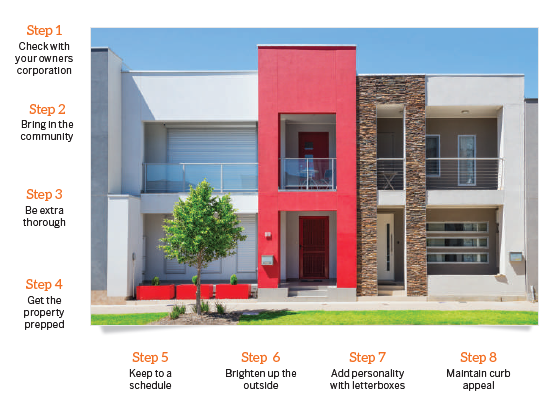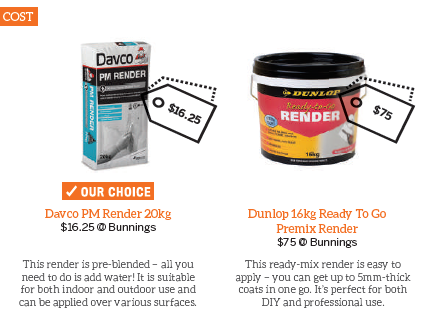When you own a unit in a block, it comes with the territory that there are parts of the property that aren’t your own. There are common areas that you share with others, and these can be difficult to manage when you’re looking to renovate.
In particular, when you want to change something as visible as the front facade, it can mean working collaboratively with other residents in your unit block. Decisions that are easily made by yourself when you’re working on a detached property now need to be counter checked by others whose property and living spaces may be affected.
Joy and Michael Williams, who have renovated many properties over the last decade, are familiar with this challenge. When they decided that the complex they owned a property in needed some upgrades, they knew the first step was to “visit all owner-occupiers and contact the owners via email to discuss the project”.
“Michael provided brochures and samples for everyone at the annual general meeting of the body corporate, and we then met at the block as a group. This can be time-consuming and difficult,” Joy says.
But it’s worth it in the end, as Joy’s end result (see page 14) demonstrates. She mentions that a key reason for their external renovation’s success was that they familiarised themselves with the infrastructure of the building and its operations – including the sinking fund, the budget for maintenance and repairs, past expenditure and projected expenses – so they could effectively plan their big upgrade. Read on to find out how they did it.
“We visited all owner-occupiers and contacted the owners via email to discuss the project”
STEP ONE: CHECK WITH YOUR OWNERS CORPORATION
Even if you’re just doing a cosmetic renovation you may require approval from the owners corporation, especially if it’s outside. It’s crucial to find out exactly what you’re getting into before you really start planning the project itself.
“It was important to go through the details of the Owners Corporation Certifi cate, which helps to provide an understanding of the current financial situation, the infrastructure, and the dynamic of the owners corporation,” say Joy and Michael.
If you’re limited in terms of scope after reviewing the certifi cate, little things like a nice new front door can add some much-needed flair to your property’s exterior.
TOP TIP
You will often need to apply for a special levy in order to move forward with an external renovation in a body corporate setting. Be ready with some proposals for a special levy structure that you can get the other unit owners to agree on.
STEP TWO: BRING IN THE COMMUNITY

“Arguably the most important step is to get everyone – or as many as you can – on board,” say Joy and Michael.
What you do with a unit block affects everyone – the project and concept may be your own, but even if you’re the one doing the actual work, you want the neighbours to agree with your plan and support you when you require an additional levy, otherwise there could be issues in the future even over even minor details, like a slight change in paint colours.
“Michael went to Bunnings and researched popular exterior colours on trend at the time. Finally, the group chose a colour that we were all happy with,” says Joy.
TOP TIP
If you want to renovate a unit block, try working with a smaller block, “preferably less than 10 units”, say Joy and Michael. This means your work affects fewer people, and it’s easier to reach a group consensus.
STEP THREE: BE EXTRA THOROUGH
It’s hard to manage when things go wrong in any renovation project, but it’s especially hard to make a mistake when you’re working with a collective group of owners in a unit block.
Sourcing the right tradies can make a massive difference, particularly when it comes to major works like rendering walls.
Take the time to discuss the project carefully with contractors – be straightforward about what you expect from them. Make sure there’s mutual understanding as to what is included in the quotations, as you don’t want unpleasant surprises regarding cost once the work begins. And of course, get several quotes for every job; you don’t know where you’ll find the best deal.
TOP TIP
When it comes to selecting tradies, Joy and Michael advise “choosing quality over a cheaper price. Research a tradie’s past work, and search for reviews and references”. You want someone who can deliver on big jobs, rather than taking the risk on a cheap and cheerful tradie who isn’t as experienced.
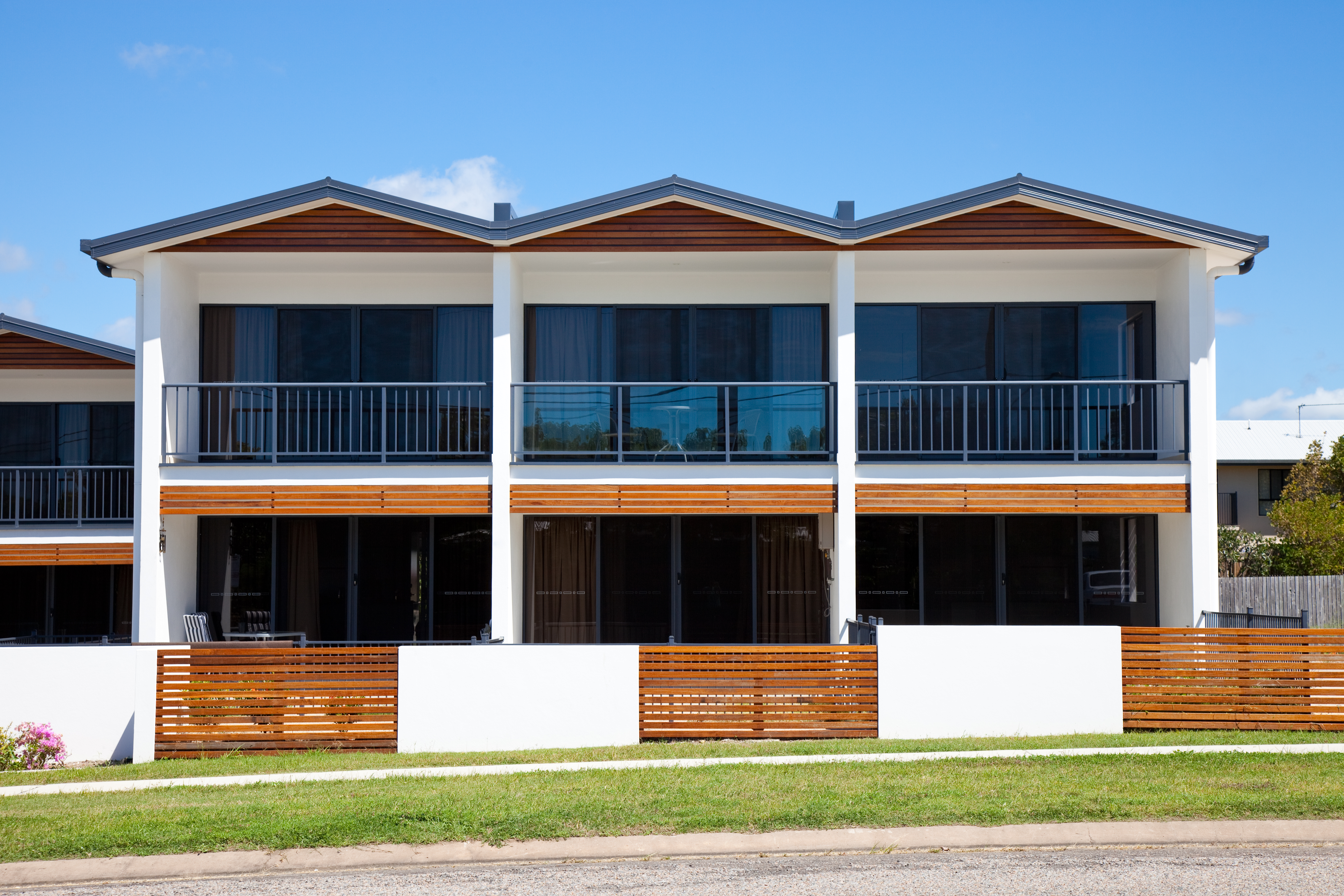
STEP FOUR: GET THE PROPERTY PREPPED
Once you’ve chosen a contractor, arrange for the special levy for funding to be passed as early as possible. Next, do a final consultation so you can begin the work.
“Contact the contractor to set a start date, then go through any fi nal details and conduct a pre-site inspection,” Joy and Michael advise.
“Communicate the start date with all owners via email and a letter in each letterbox so everyone is aware of when the project is happening.”
You also want to ensure that other aspects of the property are ready for the works – for instance, have maintenance done on the garden before starting on a paint job, so one doesn’t impact the other.
TOP TIP
Before embarking on a cosmetic reno, pay attention to fixtures like pipes, windows and front doors. An old, crumbling window in dire need of replacement can become a serious setback if not dealt with early on. Joy and Michael suggest organising a ‘working bee’ with other owner-occupiers to help get the property ready.
STEP FIVE: KEEP TO A SCHEDULE
When your renovation affects other owner-occupiers, timing is a deal-breaker. You need to work fast and keep strictly to the timeline you’ve given the community.

Knowing you have your eye on them keeps contractors accountable and prevents them from slacking off. You can also catch problems early on; for instance, the couple was able to ask the painter to redo work they were not satisfied with so it didn’t impact on the set schedule.
TOP TIP
Try to get feedback from the other unit owners on a regular basis so that they’re able to voice any concerns about the ongoing works early on. This also helps them feel more involved in the process.
 STEP SIX: BRIGHTEN UP THE OUTSIDE
STEP SIX: BRIGHTEN UP THE OUTSIDE
A little additional greenery will always be an advantage when it comes to enhancing the look of your front facade.
There are different types of plants you can cultivate based on what the OC allows. For instance, climbers like star jasmine are major space savers that can help your paint job stand out.
You should also consider plants that are durable in most weather conditions so you don’t have to risk having to replant often. If you like the idea of having a tree to accentuate the front facade, choose a species that is slim and easy to prune so that it won’t overwhelm the space.
TOP TIP
Before introducing plants into your building’s front yard, check with the owners corporation to ensure that they will be able to receive the care and maintenance they need. Dying plants can give off an air of general neglect.
STEP SEVEN: ADD PERSONALITY WITH LETTERBOXES
A new letterbox is a great way to COST improve your front facade’s aesthetic while still being functional. Aside from freestanding individual letterboxes, there are many products out there for multiple units, so this is something else you can decide on as a group.
You can choose from designs that are sleek and minimalist for that modern urban vibe. Alternatively, you can go for vintage looks that create a homey, quirky vibe. There are also letterboxes that fi t, well, only letters, but you can get letterboxes with enough space for small parcels as well. It’s all about what the community needs.
TOP TIP
Uniformity is best when you’re changing the letterboxes for a unit block. Mismatched boxes can be jarring and messy to an outside observer, so it’s important to find a design that appeals to everybody.
STEP EIGHT: MAINTAIN CURB APPEAL
Many factors contribute to the COST curb appeal of a property, not just your front facade. Things like the state of the greenery in the building’s front yard or garden can affect how potential buyers or renters see the property as a whole.
“After the painting has been completed and you’re ready to sell, it’s important to keep the garden and building maintenance up to date for the duration of the sales campaign, as potential buyers may be doing a drive-by or walk past the property at any time,” Joy and Michael explain.
TOP TIP
The gardener hired by the OC is generally responsible for the upkeep of the garden in common areas, but it’s always wise to double check your responsibilities when it comes to maintenance.
CASE STUDY
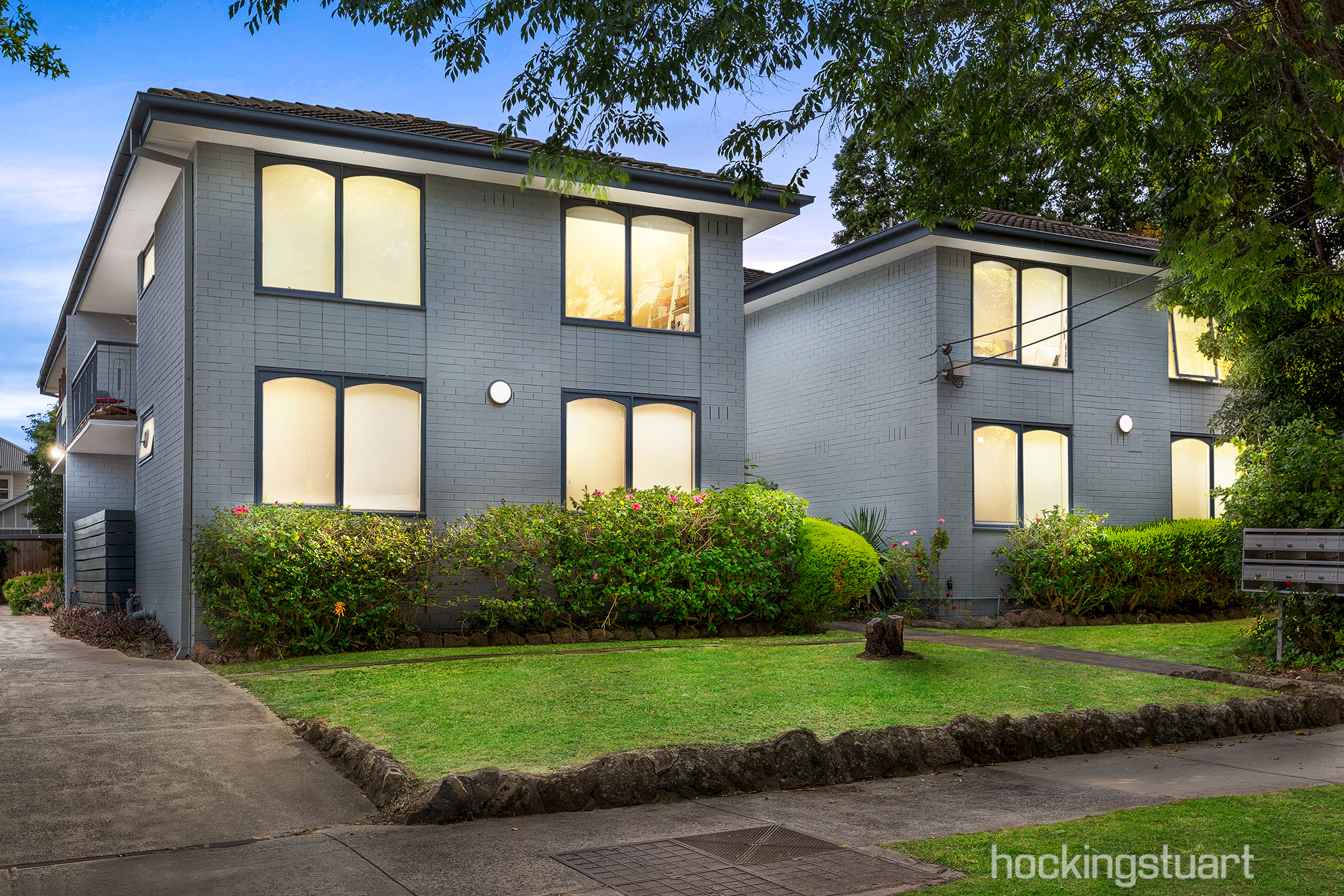
Joy and Michael Williams knew that the unit block they had bought in Boxhill, Victoria, was in need of a fresh paint job, and it was up to them to make it happen.
The block was under the management of an owners corporation (OC), so the couple went through Section 32 of the OC certificate to determine the sinking fund and the budget for scheduled maintenance and other issues. They also approached the committee’s chairperson, who agreed to give his full support to the project, including exterior painting, landscaping and maintenance.
Joy and Michael got in touch with the other owner-occupiers in the block prior to the annual general meeting, which is where they presented their ideas. The couple prepared for it by getting quotes from contractors, so they came to the meeting making it easy for others to say yes. Michael also researched trendy paint shades at Bunnings so he could provide samples to the other unit owners.
“Michael spent 40 minutes to an hour going through the scope of the work onsite with each of the six contractors to ensure they all understood what they were quoting on. We made sure we included all common areas: entry foyer, stairwell, hallways and all unit front doors,” Joy says.
Once a consensus was reached on the project, the owners corporation had to issue a special levy to fund it.
“The quotation we went with was $19,000, which meant we needed to raise a further $14,900 to cover the cost. This was $1,490 per unit – an affordable one-off payment.”
Before the exterior could be painted, repairs and maintenance to the pipes, windows and garden were completed so the painter could move freely around the building. Once the painting began, Michael would visit the site daily to inspect it, taking feedback from other owner-occupiers on the paint job.
The couple’s strict attention to detail paid off, and the finished product was a hit.
“The response from the owners was fantastic! Completing the works added significant value to our unit, and we also had really good feedback from prospective buyers at open inspections!”
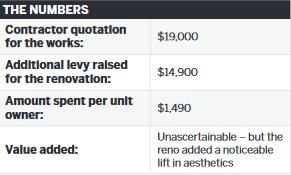
Disclaimer: All products and prices listed are correct at the time of printing. The advice contained in this article is for general information only and should not be taken as fi nancial advice. Please make sure to speak to a qualifi ed professional person before making any investment decision
